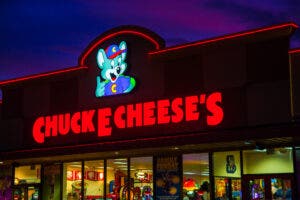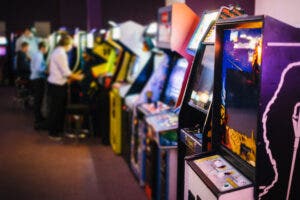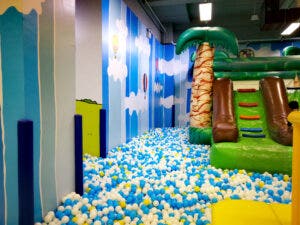Family Entertainment Centers are Bouncing Toward Inflatables
When most people hear the phrase “family entertainment center,” they probably think of a TV stand in their living room. Few people think of what is more popularly known as a “family fun center.” But that vernacular hangup hasn’t thwarted the explosive growth of the indoor amusement center craze.
Family entertainment centers (FEC’s) are experiencing a sort of renaissance in the party and event space today. At this year’s IAAPA show, there are no fewer than nine separate panels discussing FEC-related subjects, from social media strategies to staff training to data procurement, and more.
You’ve probably seen quite a few new FEC businesses open in your town in the past few years. They’re everywhere. Children and teenagers can enjoy some pizza or burgers, play some video games, and blast their friends in laser tag. And more often than not, these family entertainment centers offer a myriad of other fun games, too.
Back in the 1980’s and 1990’s, most family entertainment centers featured just a few basics. They’d usually have pizza or other fast food, arcade gaming, bowling, and maybe a ball pit or miniature golf. Some of them had roller skating rinks, too. The FEC industry was booming back then, mostly propped up by the profitability of arcade games.
That would all change in the 2000’s, though. The tragic death of the American arcade mostly laid the FEC industry to waste. Few businesses could pivot away from arcade games and retain their customer bases.
Today’s resurgence of family entertainment centers is anchored on diversified play. And as we’ll discuss shortly, inflatables like bounce houses, water slides, and inflatable obstacle courses are playing significant roles in this new FEC boom.
It all Started with a Terrifying Robotic, Singing Pizza Rat
To understand the modern resurgence of family entertainment centers, we need to first understand the birth of the FEC as a concept. And for that, we need to pay a visit to a singing robotic pizza rat with the same name as a psychotic, murderous children’s doll. Sorry to upend your childhood, folks!
 Back in the 1970’s, Atari co-founder Nolan Bushnell was looking for a way to get his arcade games into the hands of children, which required getting them out of the bars and smokey pool halls they were known at the time to inhabit. Arcades did exist, but their clientele in the earlier 1970’s were mostly older teens and young adults.
Back in the 1970’s, Atari co-founder Nolan Bushnell was looking for a way to get his arcade games into the hands of children, which required getting them out of the bars and smokey pool halls they were known at the time to inhabit. Arcades did exist, but their clientele in the earlier 1970’s were mostly older teens and young adults.
Bushnell needed a family-friendly location for his games to thrive. So, in 1977, he opened his first Chuck E. Cheese’s Pizza Time Theatre location in San Jose, California.
Chuck E. Cheese featured pizza and arcade games, as well as life-sized animatronic robots that would sing and dance for the families in attendance. Chuck E. Cheese and ShowBiz Pizza Place (their rivalry in the early 1980’s is a pretty interesting story) helped bring gaming to children, and as a result, arcades themselves catered more toward children over time as well.
The two companies eventually merged, and Chuck E. Cheese is now one of the largest FEC chains in America. There are other chains too, including Dave & Busters, Adventure Landing, Regal Cinemas FunScape, and a few others. But most family entertainment centers around the country today are small, local, family- owned and operated businesses.
Why are Family Entertainment Centers Abandoning Arcade Games?
 Arcades were highly profitable all through the 1980’s until the late 1990’s, when arcade gaming started to die out. Up to that point, family entertainment centers could rely on their arcade games as dependable revenue streams. So when arcades began to die in the late 1990’s and early 2000’s, so too did many family fun centers that had failed to diversify their revenue streams.
Arcades were highly profitable all through the 1980’s until the late 1990’s, when arcade gaming started to die out. Up to that point, family entertainment centers could rely on their arcade games as dependable revenue streams. So when arcades began to die in the late 1990’s and early 2000’s, so too did many family fun centers that had failed to diversify their revenue streams.
So why did arcades die? Why isn’t anyone out there building new arcades today? Simply put, they’re no longer economically viable. The machines are too expensive to operate, versus how much revenue they can potentially generate.
An arcade machine costs thousands of dollars to purchase; modern arcade games can cost anywhere from $3,000 to $12,000 or even more. The games are designed to keep players pumping money into them on the regular, which is how they’re profitable. But given how expensive they are, the old model of charging a solitary quarter just isn’t cutting it.
Let’s say you have a player coming in with $5 to spend on gaming. That’s twenty quarters, enough to keep them entertained for 30 to 60 minutes.
Your arcade is only earning $5 in that window. So for a $5,000 machine, you’ll need 1,000 hours of gameplay to pay back the purchase. And that 1,000 hours of gameplay will lead to maintenance and electric costs, too.
The solution, it would seem, is to charge more. But suddenly that player’s $5 isn’t stretched as far. They can’t play as long. Maybe they’ll be willing to spend more money to fill up that hour they’re trying to waste, but at some point it becomes cheaper to just buy a game for your home console and play it on your sofa as much as you want.
Family Entertainment Centers are Learning Revenue Diversity
Modern family entertainment centers aren’t relying on arcade gaming as much as their forefathers did. While arcade gaming is still pretty popular in the FEC sector, most businesses are learning the real value of revenue diversity. And that core concept of earning income through as many sources as possible is helping insulate and future-proof family fun centers, too.
These indoor playgrounds are more than just pizza and video games now. Many FEC locations feature indoor blacklight mini golf, rock climbing walls, go karts, bumper cars (and/or bumper boats), rope courses, trampoline parks, ziplining, and high tech items like virtual reality play areas or LAN PC gaming (where you’re connecting lots of computers together, all in one room, and playing a game together but separately).
Another big ticket item for FEC operations? Commercial inflatables, which have been rapidly growing in popularity in that space. Bounce houses and other inflatables are wildly popular in family fun centers these days, and for lots of good reasons.
Commercial Inflatables Fulfill FEC Needs
Indoor amusement parks need to find the perfect games and attractions to draw in crowds. But what features make a game or attraction highly desirable for a family fun center? Here’s the shortlist:
- Safe and fun for customers
- Pays for itself in a reasonable amount of time
- Durable; heavy duty construction that can withstand daily commercial use
- Easy to set up, take down, and move around
- As maintenance-free as possible; workers should be able to make repairs with minimal training or experience
- Minimal utility costs
If you work in the party rental industry, chances are you already know the perfect candidates. Ones that match those six conditions flawlessly: commercial inflatables. And many family entertainment centers are learning that bounce houses, inflatable water slides, inflatable obstacle courses, zorb balls, and sealed air frame games are perfect additions to their businesses for those exact reasons.
Bounce houses and other inflatables are incredibly simple to set up and take back down. Cleaning a bounce house and patching a bounce house are both remarkably simple and cost effective, too. Their utility costs are low, and since these inflatables don’t need to be brought to parties or events, there aren’t any costs associated with travel or transportation.
Bounce houses weren’t nearly as popular in the 1980’s and 1990’s as they are today, which is why most family fun centers never invested in them back then. And that’s a shame, because their ease of use and high allure would have made them genuine cash-cows. Many of those businesses may even still be around today had they been given such a strong alternative to arcade gaming to diversify their revenue with.
Bouncing Family Fun Center Profits with Inflatables
 There aren’t really any prevailing income models for family fun centers. Some charge admission fees and grant open access to all of their attractions and games for a full day. Some charge for each attraction or game individually. Others charge admission to cover attractions, like go karts or mini golf or inflatables, but arcade games, skeeball, sealed air frame games, and other similar games cost additional fees.
There aren’t really any prevailing income models for family fun centers. Some charge admission fees and grant open access to all of their attractions and games for a full day. Some charge for each attraction or game individually. Others charge admission to cover attractions, like go karts or mini golf or inflatables, but arcade games, skeeball, sealed air frame games, and other similar games cost additional fees.
Bounce houses, water slides, and obstacle courses make for great attractions because of their physicality. Guests will eventually get tired and move on to another attraction. As much fun as a bounce house can be, it’s rare someone will bounce in one for more than 15 to 20 minutes at a time, let alone a full hour straight. So general admission models and day passes work great for covering bounce house access.
Inflatable sealed air frame games work well as pay-per-play games and can hold their own with installed games, like skeeball, as redemption based units. Players hand you some money, play the game, and can then win prizes, either directly or in exchange for tickets earned by playing.
Inflatables have low overhead costs and low maintenance requirements. They’re safe and fun, and a great way for parents to tire out their kids and provide them with exercise in a constructive way. They can be taken down and moved around more easily than traditional installed attractions or games.
The question isn’t whether or not inflatables bring value to family entertainment centers, but why an FEC wouldn’t strongly consider adding some to their facility out of the gate. There frankly aren’t any other attractions or games in our industry that bring as much value at similar investment costs.
Family Entertainment Centers are Embracing Inflatables. Are You?
This new era of family entertainment centers has learned from the mistakes of those that came before them. They’re not gambling on arcade gaming and pizza sales. To make it as an FEC in this day and age, you need to embrace variety.
Arcade games and pizza might serve as a decent place to start, but laser tag, go karts, mini golf, batting cages, and inflatables ensure your company’s longevity and make you stand out from local competitors. Providing customers with lots of options and different ways to enjoy their time helps bring them back sooner, too.
Have you ever been to a really big buffet, where you end up looking forward to going back just to try all of the foods you missed out on? It’s that same principal.
Or perhaps a more fitting example, an amusement park. You can’t do every single ride in one day (and if you can, provide us all a moment to bow to you). You end up wanting to go back to try them all, and to pay a visit to your old favorites while you’re at it.
Family entertainment centers that embrace attraction and ride diversity aren’t guaranteed success, of course. You need to be careful not to overfill your space or over-invest in too many units to see a reasonable return over time. But companies that aim for diversity will almost always prevail over those that don’t.
Your FEC can certainly survive without inflatables. But the family entertainment centers that utilize them generally invest in more over time due to how popular and successful those inflatables tend to be. You don’t need to use inflatables, but chances are you’ll have a pretty hard time coming up with logical reasons not to.


